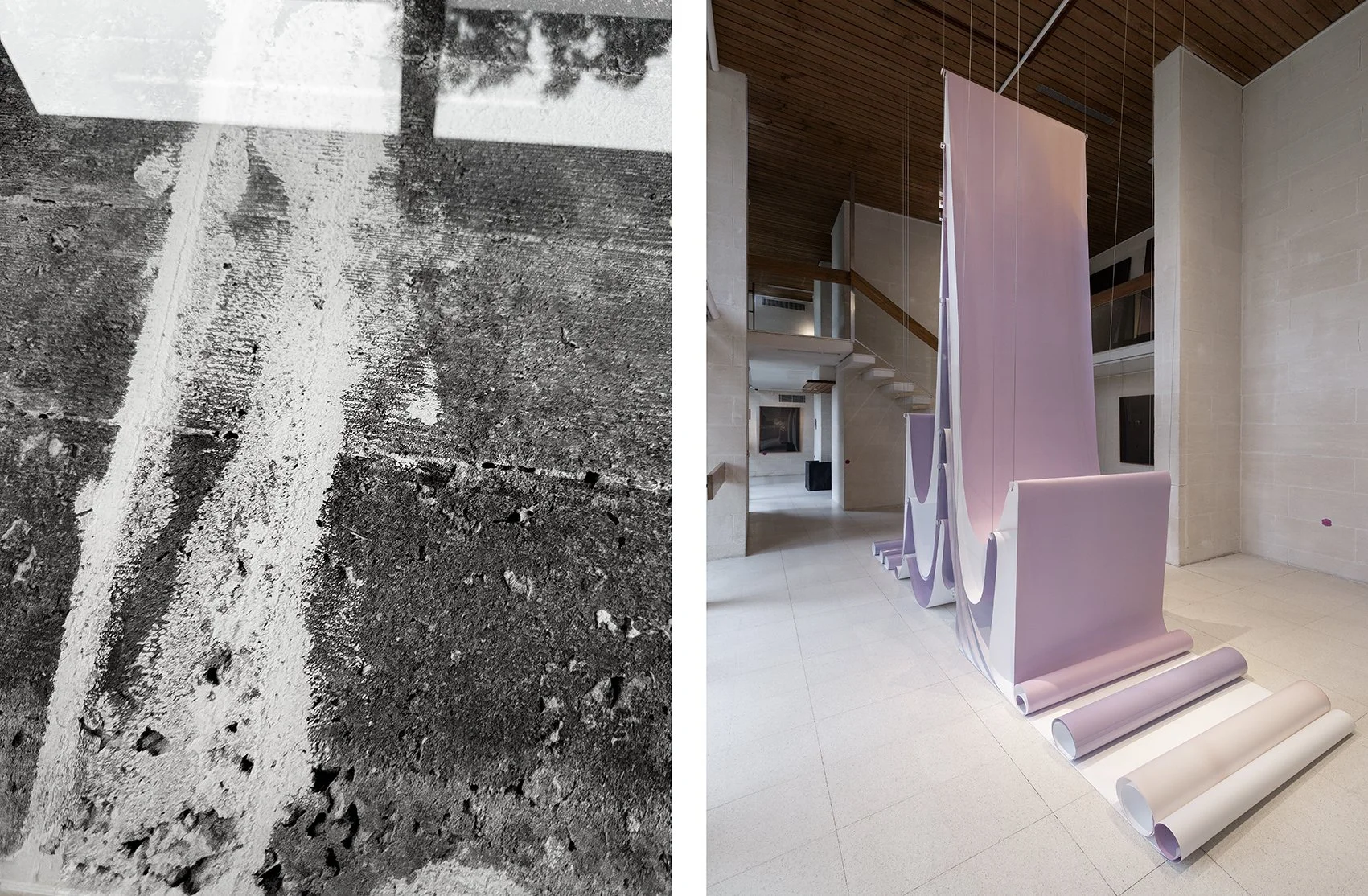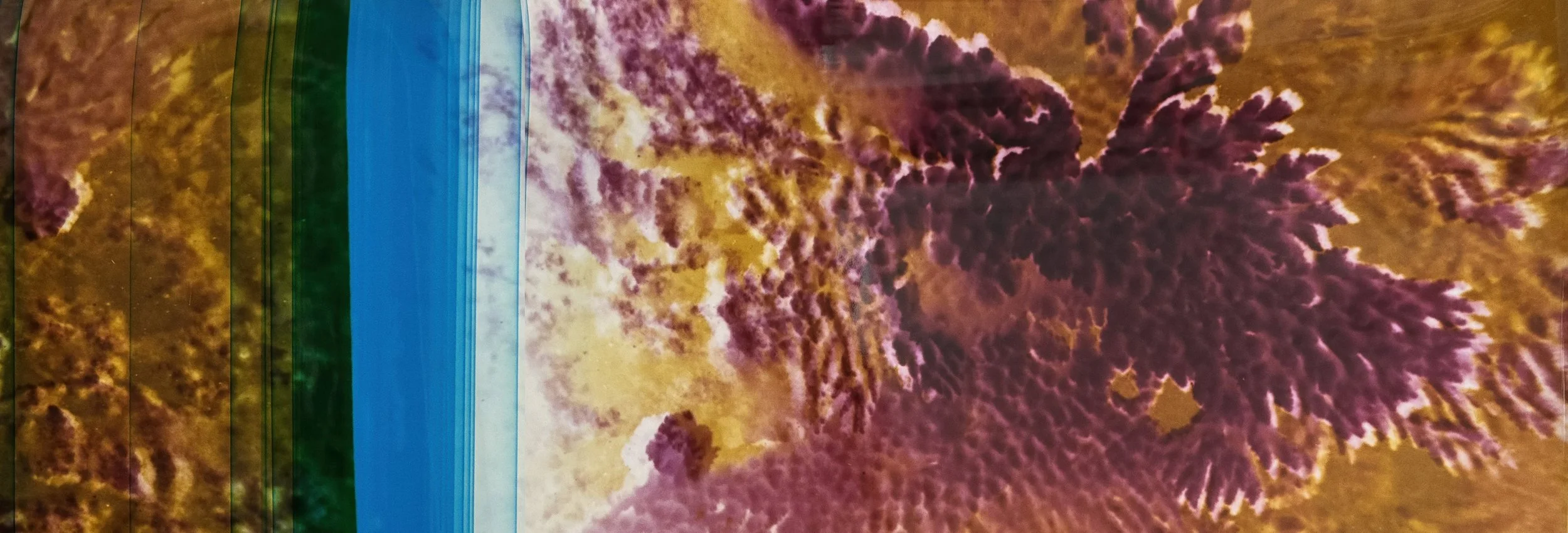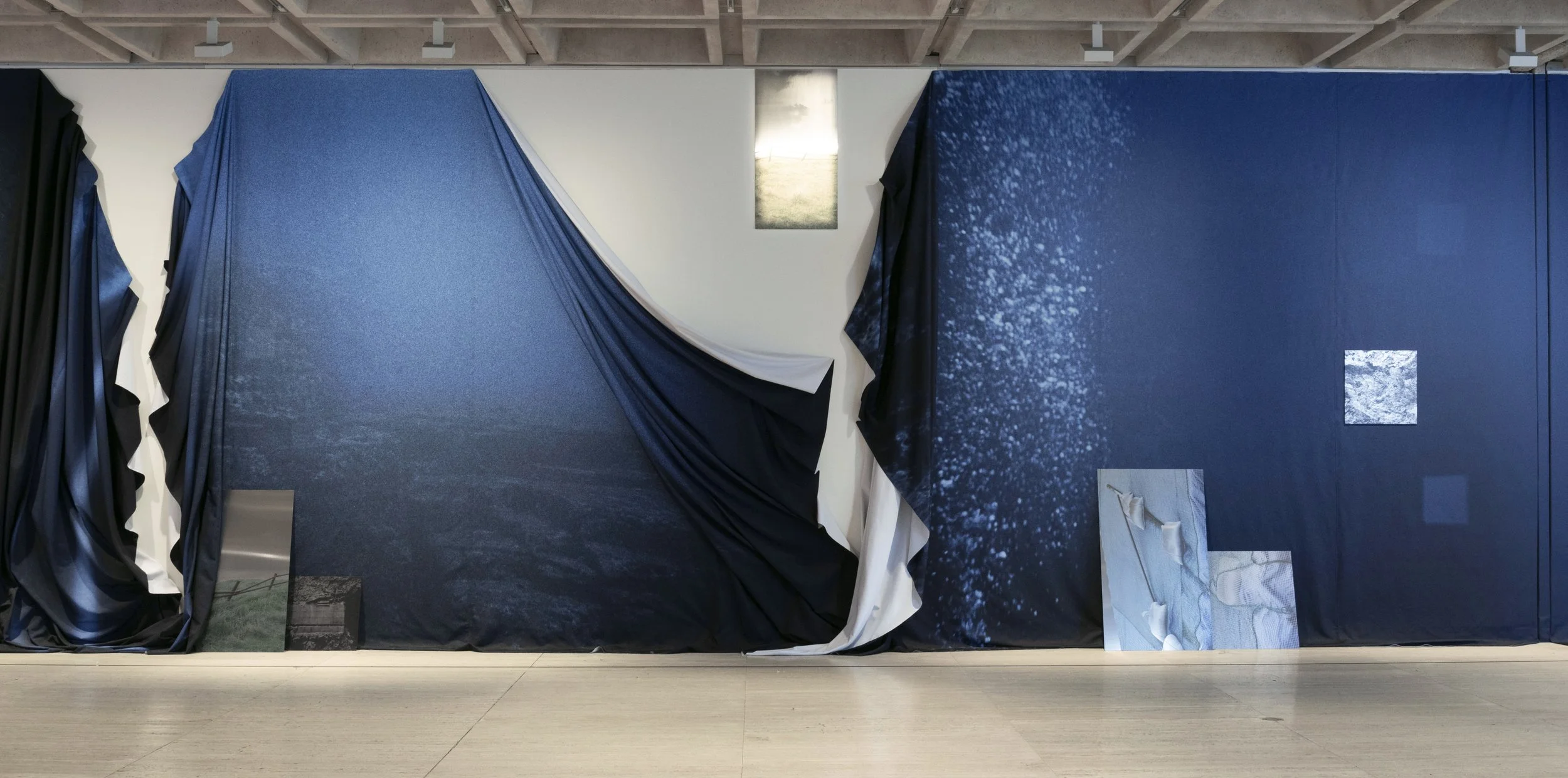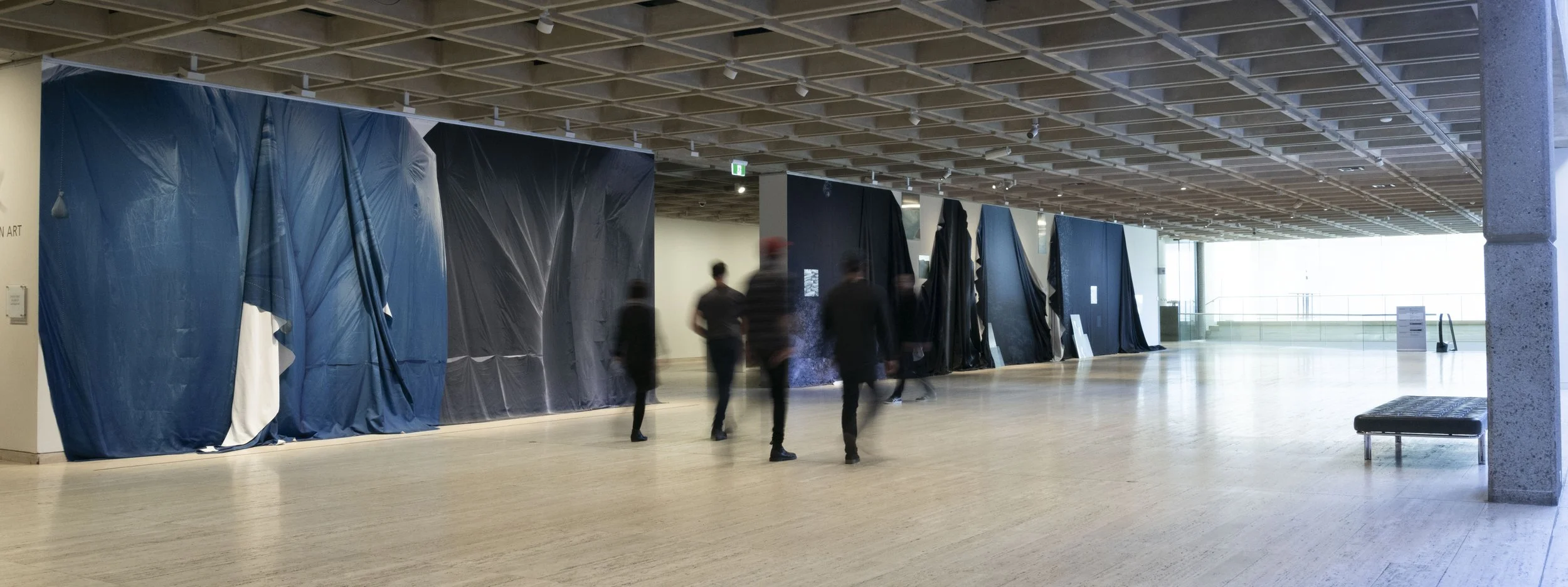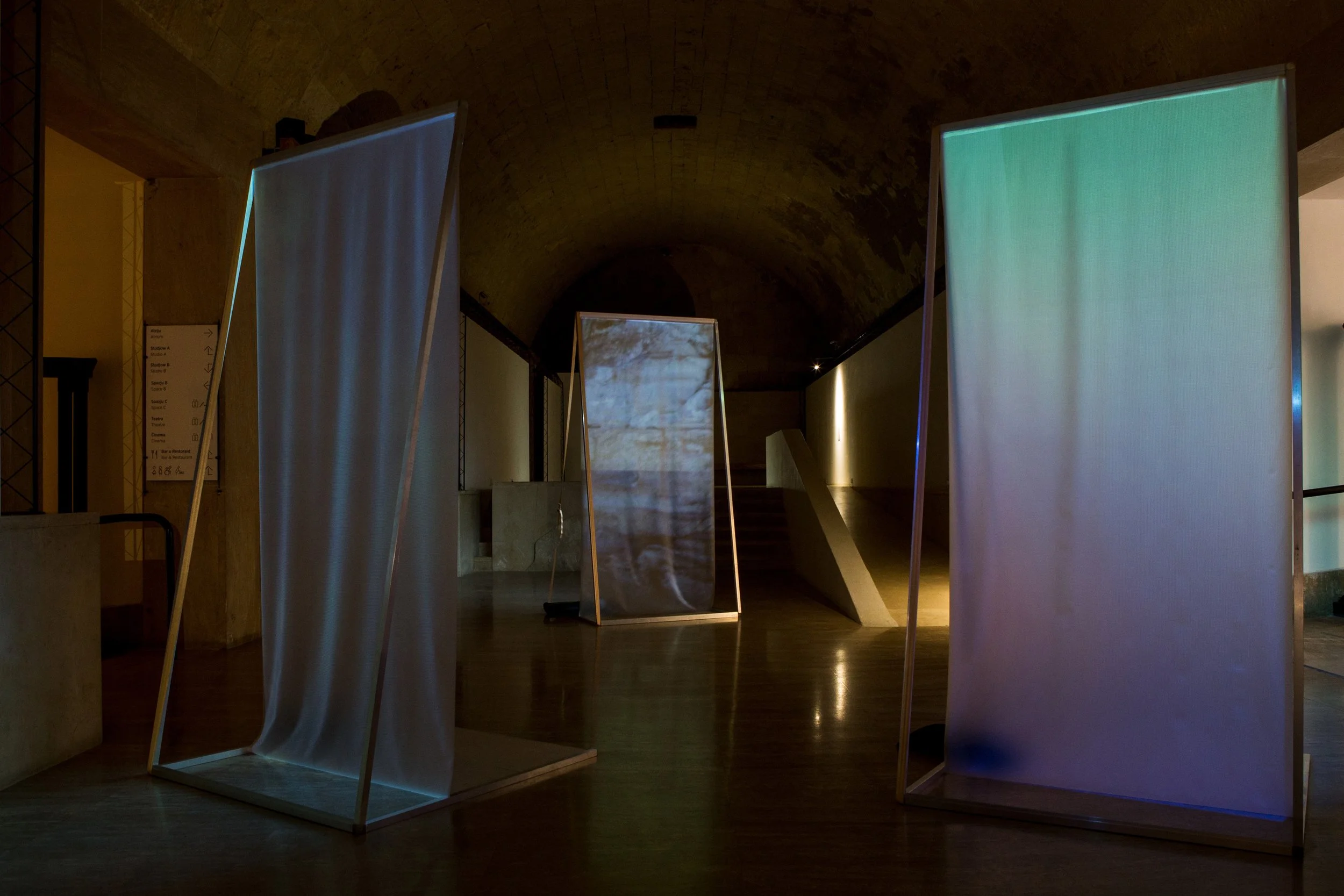IZABELA PLUTA
support material: 10 images of past work/exhibitions
email@izabelapluta.net
www.izabelapluta.net
@izabelapluta__studio
Izabela Pluta Lumina
Heide Museum of Modern Art, Melbourne. Curator: Melissa Keys
Light Ledger 2025. fixed Lumen prints on silver gelatin paper, acrylic and stainless steel; Understructure 2025 (detail) , UV-cured inkjet prints on glass. Photos: Christian Capurro
This expansive installation transforms Heide Modern into a living photographic instrument, where architecture, light, and time become active agents in the work’s unfolding. Over eighteen months, silver gelatin paper was laid directly onto the terrazzo floors, turning the building into a site-scale camera that slowly inscribed the shifting geometries of light and shadow across its surfaces. These seasonal exposures, alongside lumen prints, glass-mounted photographs, and sculptural interventions, propose a material and temporal register that resists photographic fixity. Works such as Light Ledger and Understructure extend this logic, capturing light’s incremental passage and the unseen architectures that scaffold the domestic space. In counterpoint, images of Pluta’s childhood home in Warsaw—printed onto transparent glass—layer a second geography onto the museum, merging personal memory with institutional history. Through this interplay of inscription, reflection, and spatial dislocation, Lumina invites viewers to move through a mutable field of light and matter, where photography becomes less a record of a single instant than an embodied encounter with duration, entropy, and the porousness of place.
Izabela Pluta
Like folds in water (Caustic Network) 2024, commissioned The force that binds us, The Australian Centre for Contemporary Art, curated by Shellry McSpedden. Chromogenic photographs, water-based latex ink on synthetic paper, UV Nano ceramic solar film, Dichronic window film, digital video, stage lights, bronze aluminium. Photo: Andrew Curtis
This large-scale installation work embraces the unfamiliar oceanic conditions of orientation, materiality, and vision, drawing parallels between the immersive and spatial experiences of diving and those akin to working in a darkroom.The multi-faceted installation takes the extraordinary spectral vision of a Mantis Shrimp as its cue to explore oceanic conditions of orientation through an eclectic photographic materiality. The work incorporates mural C-Type photographs that are the result of darkroom processes involving principles of solarising and combining negative and positive images. Derived from scientific transet data post-bleaching events experience on the East Coast of Australia earlier this year, the pictorial qualities of the images are bent and expanded through non-traditional processes where light behaves unpredictably—refracted and scattered, symbolising the spectral qualities of light as experienced beyond human perception.
IIzabela Pluta Apparent Distance (detail) 2019. Dye-sublimation prints on fabric and photographic prints on aluminium; 340x850 cm, 340x2059 cm (overall installation). Curated by Isobel Parker-Phillip, commissioned by the Art Gallery of New South Wales for The National 2019: new Australian art.
Developed while diving in response to a sunken rock formation on the cusp of the Pacific Ocean and East China Sea, this 30-meter installation uses drapery as a visual strategy to metaphorically suspend reality, evoke precarity, instability and change. Made during fieldwork diving the ruins of the underwater rock formation, the project experimented with a series of pictorial textiles, suspended to make the form appear like it is on the wall, but also falling off its surface. Elements included fragmented images on aluminium, that provided a play of light and experienced differently at distance and close proximity.
Izabela Pluta Counter forces, 2021, pigment prints on Eco Solvent Cotton Rag paper, repurposed timber easels, studio backdrop, paper, bronze. Commissioned by Bundanon Art Museum for From impulse to action, curated by Sophie O’Brien. Photo: Zan Wimberley.
Counter forces destabilised the transformation and representation of landscape. It explored the interpretation of Bundanon and its surrounds into an artwork that looked tested the complex geography of the site. This ambitious project evoked the coalescence of spatial and temporal excavation through photographic collage and sculpture. The printed surface formed a sail-like body in the 7-meter vertical wall work was anchored by sculptural components comprising bronze hands and repurposed timber painting easels. These elements alluded to traditional taxonomies of musicological display, re-staging and mixing artworks with artefacts to blur hierarchies of ordering.
Izabela Pluta Variable depth, shallow water (detail) 2020. silver gelatin photographs, pigment prints on, aluminium dye-sublimation prints, polyester waddling straps, two-way acrylic, aluminium, polyester resin, 600 x 200 x 150 cm. Curated by Jose Da Silva. Installation view, UNSW Galleries Sydney. Photo: Jacqui Manning
Capturing the innately disorienting rehabituation that takes place underwater, this work creates a series of complex picture planes that descend, hang and jut up from the cage-like structure, an assembled aluminium harness that both enables and compromised the viewer’s path around the work in the gallery space. The large-scale installation combines materials such as photographs printed on aluminium, traditional darkroom prints using a camera-less process (involving outdated oceanic atlases) and luscious colour scenes of aerials that use corrupted data, filmed using a drone lost at sea and subsequently retrieved. These moments of encounter evoke the way in which the lens-based components are seemingly precarious in their position to the other objects, and the viewer, where legibility and clarity are constantly in flux.
Izabela Pluta
Use-wear (2022- )
8-channel video (detail, work in progress), commissioned by The Powerhouse Museum during my role as Artistic Associate.. Presented as part of Powerhouse Late’s: Photography, March 2023. Photo: Chris Mulia
Izabela Pluta Lines of sight 2020. 3 channel digital video with sound, polyester waddling straps, two-way acrylic, aluminium. 06:25 minutes (loop). Installation view, Spazju Kreattiv, National Centre for Creativity Valletta, Malta. Curators: Nicole Bearman and Francesca Mangion.
Drawing on the reflexivity and instability of the photographic medium, this work uses images, video, objects and sound. The installation’s key material includes corrupted data, filmed using a drone lost at sea and subsequently retrieved. Inspired by Dwerja (a fallen sea stack off the coast of Gozo, in Malta) the concept of deep time, the instantaneous moment of change, and informed by Pluta’s own passage as a migrant to Australia, the work investigates the uncertainty of location. Using moving images as a form to explore how diving is a way to embrace groundlessness, immediately shifting our perspective away from the landlocked, inhibiting our language, and augmenting our breath.
Izabela Pluta Ascending air, unfolding motion, 2022, latex-based ink-jet prints mounted on aluminum, repurposed timber easels. Created through the commissioning support of The Lockup, Newcastle for Radical Slowness, curated by Anna May Kirk+Tai Mitsuji. Photo: Ben Adams. Collection Maitland Art Gallery.
This work involved harnessing sunlight as an exposing device to engage with the climatic conditions inherent in the source imagery. I cut, collaged, scanned, and enlarged the photographic cyanotype to merge two sides of an original book page from Cloud Study: A Pictorial Guide, 1960 to reveal the weather patterns on the day my family and I left Poland in 1986. Embracing horizontal tears, from physically superimposing one image onto another, the installation alluded to a spatial and temporal rupture through the precarious ordering of materials, and by the risk of ruining the image further through the tears created.
Izabela Pluta – Nihilartikel
Artist book, 128 pages, 31.7 x 24cm, coptic bind, softcover, Perimeter Editions (Melbourne), 2022
The German term nihilartikel is used to describe the little known practice of inserting intentional errors, falsities or fictitious entries into reference texts – academic works, dictionaries, encyclopedias, maps, directories – for the purpose of later identifying plagiaries, copies or other infringements to intellectual copyright. Taking this somewhat elusive practice as its subtext, Izabela Pluta’s major new book approaches photography and its central quandaries of authenticity and representation from a series of unsettled and dynamic vantages.
Here, the Polish-born, Australian-based artist forges a syntax using photographs gleaned from aerial drone footage and moving-image stills filmed underwater in Malta and Japan, and experimental darkroom prints made with out-of-print and otherwise obscure oceanic maps. Ancient surfaces and architectures ripple with evidence of their deep time; boulders emerge, stealth-like, from the blue depths; cartography collapses in on itself; all in a sequence punctuated by vibrant interplays of colour, layer, texture and form.
Izabela Pluta
Cavitation 2018
three-channel video with audio, duration 9:06 min
installation view, Geography of Space, Archaeology of Time , Australian Centre for Photography, Sydney, curated by Allison Holland.
The process by which the depth of the sea is defined 2018
dye-sublimation print on acoustic fabric
Photo: Michael Waite
